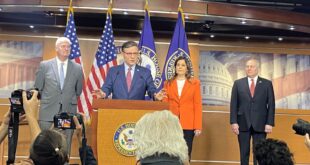Julia Conley, Common Dreams
New food insecurity data released by the U.S. Department of Agriculture on Wednesday provided the latest evidence that the enhanced child tax credit and other relief programs passed in the first two years of the Covid-19 pandemic significantly helped millions of Americans to support their families last year—and with much of the aid now ripped away, more households are again struggling to make ends meet.
The agency’s annual report on food security showed that about 1 in 10 homes—or 13.5 million households—did not have enough food in 2021. Overall food insecurity remained the same from 2020 to 2021, and grew worse for women and older Americans living alone, but among families with children, there was a sharp drop in 2021.
“The prevalence of food insecurity declined from 2020 to 2021 for a few population subgroups, including households with children under age 18 and with children under age 6, married couples with children, and single mothers with children,” reads the report.
Last year, 6.2% of households with children were unable to provide adequate and nutritious food for their children, down from 7.6% in 2020.
“The social safety net for families with children was better in 2021 than it has been” in the past, said Sarah Bowen, a sociologist at North Carolina State University, on social media Wednesday, pointing to the child tax credit (CTC), universal free lunches in many school districts, and Pandemic Electronic Benefit Transfer (P-EBT) cards that millions of people relied on last year.
“If we give families more money (ideally with few restrictions and hoops to jump through), food insecurity goes down,” she added.
In the second half of 2021, the monthly CTC payments provided a total of up to $3,600 per child to nearly all middle- and low-income families in the U.S.—an “unprecedented” federal program, according to the Brookings Institution, which lifted 3.7 million children out of poverty.
The Universal School Meals Program Act was passed in 2021 and provided an estimated 10 million schoolchildren with free lunches at school, and millions of families received extra assistance to buy food through the expansion of the Supplemental Nutrition Assistance Program (SNAP) during the pandemic.
But when right-wing lawmakers including Sen. Joe Manchin (D-W.Va.) refused to expand the CTC, the child poverty rate shot up by nearly 5% in just one month. Congress also failed to extend the universal school lunch program in June, and at least 16 states this year have declined to continue the SNAP benefits expansion.
While the USDA report contains “a lot of good news” regarding food insecurity in 2021, Diane Whitmore Schanzenbach of the Institute for Policy Research at Northwestern University told The Guardian, regular surveys by the U.S. Census Bureau this year are already showing “that food hardship has been steadily rising in families with children.”
 Poli Alert Political & Civics
Poli Alert Political & Civics



